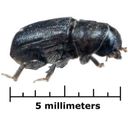Mountain Pine Beetle
Dendroctonus ponderosae
Classification
- Phylum: Arthropoda
- Subphylum: Hexapoda
- Class: Insecta
- Order: Coleoptera
- Suborder: Polyphaga
- Superfamily: Curculionoidea
- Family: Curculionidae
- Subfamily: Scolytinae
- Tribe: Hylurgini
- Genus: Dendroctonus
- Species: ponderosae
Pronunciation
How to pronounce Dendroctonus ponderosae: //ˌdɛnˈdrɒktənəs ˌpɒndəˈroʊsaɪ//
These audio files are automatically generated. While they are not always 100% accurate, they are a good starting point.
Images






Summary
Dendroctonus ponderosae, commonly known as the mountain pine beetle, is a bark beetle that infests pine forests across western North America. Its presence can lead to widespread tree mortality, particularly exacerbated by climate change, resulting in significant ecological and economic impacts.
Physical Characteristics
Hard black exoskeleton, approximately 4-7.5 mm in length.
Identification Tips
Size is similar to a grain of rice; identification may include examining characteristics of bark damage and the presence of pitch tubes on host trees.
Habitat
Native to the forests of western North America, primarily inhabiting various species of pine trees, including ponderosa, whitebark, lodgepole, Scots, jack, limber, Rocky Mountain bristlecone, and Great Basin bristlecone pine trees.
Distribution
Ranges from northern Mexico to central British Columbia.
Diet
Infests a broad range of Pinus species, primarily those that are old or weakened.
Life Cycle
Beetles develop through four stages: egg, larva, pupa, and adult, with life cycles generally taking one year in low elevation areas but up to two years in higher elevations.
Reproduction
Females initiate attacks by chewing into the inner bark and releasing pheromones to attract males, resulting in mass attacks on trees.
Predators
Predators include various birds, particularly woodpeckers, and other insects.
Ecosystem Role
Plays a vital role in forest ecology by preying on weak trees, thus aiding in forest rejuvenation.
Economic Impact
Significant forestry pest leading to dead timber which disrupts the forestry industry.
Cultural Significance
A giant effigy of a mountain pine beetle is set on fire each winter in Custer, South Dakota as part of local culture.
Health Concerns
Certain pesticides used to control beetle populations have potential health risks for humans and wildlife.
Collecting Methods
- Pheromone baiting
- Sanitation harvesting
- Snip and skid
- Controlled burning
- Fall and burn
Preservation Methods
- Freezing
- Drying
Similar Taxa
Misconceptions
Often mischaracterized solely as tree killers; actually play an important ecological role.
Tags
- Mountain Pine Beetle
- Dendroctonus ponderosae
- Forestry Pest
- Climate Change
- Pine Infestation